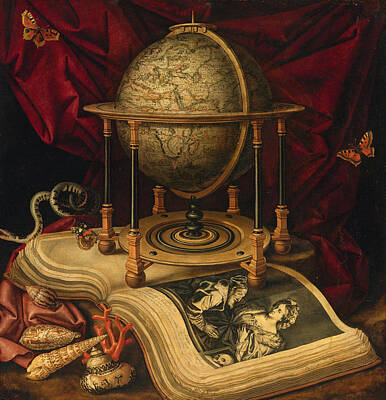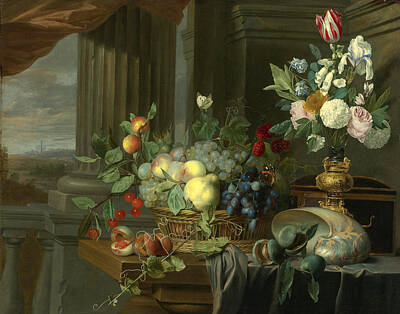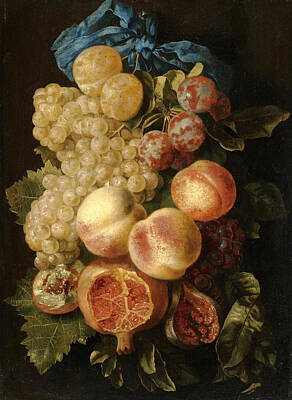Vanitas Still Life With A Terrestrial Globe A Book Shells A Snake And Butterflies
A Still Life With Plums Grapes Peaches And A Pomegranate Tied With A Blue Ribbon
Carstian Luyckx or Christiaen Luyckx also known as the Monogrammist KL[1] (1623 – c. 1675), was a Flemish painter and draughtsman who specialized in still lifes in various subgenres including flower still lifes, fruit still lifes, fish still lifes, pronkstillevens (sumptuous still lifes), vanitas still lifes, hunting pieces and garland paintings. He also painted animals and a few genre scenes. After starting his career in Antwerp he is believed to have worked later in France.
Life
Carstian
Luyckx was born in Antwerp in 1623 as the son of David Luycx en
Margriet Cloot. He was baptized on 17 August 1623.[2] He studied
painting under Philips de Marlier, a still life specialist, in 1642 and
under Frans Francken III, a history painter, in 1645.
In
1645 he became a master of the Antwerp Guild of St. Luke. He is
documented in Antwerp up to August 1653. It is believed that he left
Antwerp and worked in France as many of his later works carry French
inscriptions.[3] During his residence in France, Luyckx influenced
other vanitas painters, including Simon Renard de St. André.[4]
It is not clear when and where Luyckx died but his death date is assumed to fall between the years 1657 and 1677.[2]
Work
General
Allegory of Charles I of England and Henrietta of France in a Vanitas Still Life
Luyckx
was a successful artist who worked in many still life genres and also
painted animals and a few genre scenes. He fell into oblivion after his
death.[3] Only two dated works are known to exist, making it difficult
to establish a chronology for his oeuvre.[3]
Luyckx is known
to have collaborated with other Antwerp painters. The Gemäldegalerie
Alte Meister in Dresden holds a painting referred to as Kitchen still
life with vase of flowers, dead birds, fish and a cat. It is a
collaboration of Luyckx with David Teniers the Younger who painted the
architectural elements and Nicolaes van Verendael who painted the
flowers in a vase. Luyckx painted the game still life, bird cage, dead
fish and the cat.[5]
Pronkstillevens
A large portion of
his output consists of pronkstillevens, the sumptuous still lifes that
were popular in Flanders and the Dutch Republic from the 1640s. Luyckx’
work in this genre was influenced by the artist Jan Davidsz. de Heem
who was active in both Antwerp and the Dutch Republic. A representative
example in this genre is the Opulent Still Life with Silver and Gilt
Metal Objects, Nautilus Shell, Porcelain, Food and Other Motifs on a
Draped Table (Montreal Museum of Fine Arts). This work dates from about
1650 and is painted on copper.[6]
Vanitas
Luyckx was
especially known for his vanitas still lifes, a genre of still lifes
which are intended as a reflection on the meaninglessness of earthly
life and the transient nature of all earthly goods and pursuits. He had
followers in France such as Simon Renard de St. André and vanitas works
by Luyckx have in the past been attributed to these artists. This is
for instance the case with the composition Vanitas still life with a
skull, a violin, a musical score, a pipe and tobacco, an hourglass and
a candle on a draped table (Sold at Sotheby's on 6 December 2012 in
London, lot 201) previously given to St. André. This composition shows
a musical score, which contains a single vocal part of a religious
Latin choral composition, the text of which specifically relates to
death. The inscription on the musical score probably refers to the
16th-century composer Orlande de Lassus.[7]
Another vanitas still life is the Allegory of Charles I of England and Henrietta of France in a Vanitas Still Life (Birmingham Museum of Art). The subject here refers to the troubled life of Charles I of England and is a reflection on the suddenness of death and the vanity of early power and glory. The bubbles in the composition symbolize the brevity of the life of Charles I who was beheaded at the age of 44. The broken skull conveys the fragility of human beings and the globe symbolizes the transience of power and possessions.[8]
Hunting pieces and animals
Fowl Attacked by a Fox
His
hunting pieces (game still lifes) were influenced by the Flemish
specialists in this genre Frans Snyders and especially Jan Fyt. An
example of his hunting pieces is A hunting still life of partridges
with four Springer spaniels, a hawk, a game-bag and belt and other
hunting gear in a landscape (Sold at Christie's on 20-21 November 2013
in Amsterdam, lot 168). This work is believed to date to the
transitional phase between Luyckx’ Antwerp and French periods in the
1650s.[3]
Some fish still lifes by Luyckx have previously
been attributed to Abraham van Beijeren or followers of Alexander
Adriaenssen.[9]
Luyckx painted compositions with life animals a good example of which is the Fowl Attacked by a Fox (The Kremer Collection).[10]
Flower and garland paintings
Carstian
Luyckx painted flower paintings as well as garland paintings, a special
type of still life developed in Antwerp at the beginning of the 17th
century by Jan Brueghel the Elder in collaboration with the Italian
cardinal Federico Borromeo.[11]
Garland around three putti
Other
artists involved in the early development of the genre included
Hendrick van Balen, Andries Daniels, Peter Paul Rubens and Daniel
Seghers. The genre was initially connected to the visual imagery of the
Counter-Reformation movement.[11] It was further inspired by the cult
of veneration and devotion to Mary prevalent at the Habsburg court
(then the rulers over the Southern Netherlands) and in Antwerp
generally).[11][12] Garland paintings typically show a flower garland
around a devotional image, portrait or other religious symbol (such as
the host).[12] Garland paintings were typically collaborations between
a still life specialist and a figure painter.
Luyckx painted
a number of garland paintings. In a few of these the cartouche was
painted later by an unknown hand. An example is the Cartouche with
Flowers (Princeton University Art Museum), which shows a flower garland
around a portrait of Peter Paul Rubens painted at a later date by an
unknown artist. This may be an indication that the painting had
remained unsold during his lifetime. Luyckx rendered the flowers with
such specificity that they can be identified easily. They are a
combination of familiar Western European garden plants such as
carnations and columbines as well as exotic varieties from the Orient,
including the pink damask rose and the tulip. Luyckx included the rare
parrot tulip, an extremely expensive variety at that time.[13]
References
Still life of pink, yellow and white roses hanging from a blue ribbon with a red admiral and a cabbage white
Many
alternative name spellings: Kerstiaen Lucks, Christiaan Lux, Carstiaen
Luycks, Christiaan Luyckx, Kerstiaen Luycs, Christiaan Luycks,
Christiaan Lucks, Cartiaen Luycks, Cartiaen Lucks, Cartiaen Lux,
Carstian Lukx, Christaan Luyckx, Kerstiaen Luyckx, Christian Luycks,
Cerstiaen Luyckx
Carstian Luyckx at the Netherlands Institute for Art History (Dutch)
Carstian
Luyckx, A hunting still life of partridges with four Springer spaniels,
a hawk, a game-bag and belt and other hunting gear in a landscape at
Christie’s
Kelley, III, Raymond J. (2006). To Be or Not to Be:
Four Hundred Years of Vanitas Painting. Flint Institute of Arts. p. 64.
ISBN 978-0-939896-25-7.
Kitchen still life with vase of flowers, dead birds, fish and a cat at the Netherlands Institute for Art History (Dutch)
La donation Hornstein à Montréal (4) (French)
Carstian
Luyckx, Vanitas still life with a skull, a violin, a musical score, a
pipe and tobacco, an hourglass and a candle on a draped table at
Sotheby’s
Allegory of Charles I of England and Henrietta of France in a Vanitas Still Life at the Birmingham Museum of Art
Carstian Luyckx, Fish still life with lobster at the Netherlands Institute for Art History (Dutch)
"The Kremer Collection". Pitgroup Intech B.V. 2015. Retrieved 2015-03-13.
David
Freedberg, "The Origins and Rise of the Flemish Madonnas in Flower
Garlands, Decoration and Devotion", Münchener Jahrbuch der bildenden
Kunst, xxxii, 1981, pp. 115–150.
Susan Merriam,
Seventeenth-Century Flemish Garland Paintings. Still Life, Vision and
the Devotional Image, Ashgate Publishing, Ltd., 2012
Carstian Luyckx, Cartouche with Flowers at the Princeton University Art Museum
----
Fine Art Prints | Greeting Cards | Phone Cases | Lifestyle | Face Masks | Men's , Women' Apparel | Home Decor | jigsaw puzzles | Notebooks | Tapestries | ...
----
Artist
A - B - C - D - E - F - G - H - I - J - K - L - M -
N - O - P - Q - R - S - T - U - V - W - X - Y - Z
Retrieved from "http://en.wikipedia.org/"
All text is available under the terms of the GNU Free Documentation License





